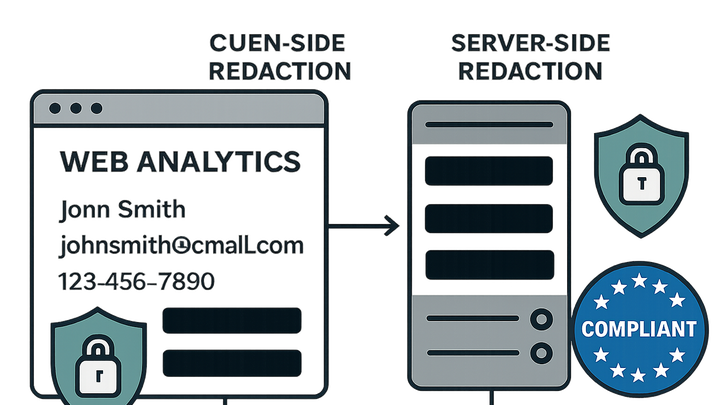Published on 2025-06-22T08:58:57Z
What is PII Redaction? Examples in Analytics
PII Redaction refers to the process of identifying, removing, or obfuscating personally identifiable information (PII) from data collected during analytics. In web analytics, PII includes names, email addresses, IP addresses, and other sensitive identifiers that can directly or indirectly point to an individual. Proper redaction is essential to comply with privacy regulations such as GDPR and CCPA, and to maintain user trust by protecting personal data. Without effective redaction, organizations face legal penalties, data breaches, and reputational damage. PII redaction can be performed at different stages—client-side, server-side, or within data processing pipelines—each with its own advantages and challenges. Analytics platforms like PlainSignal and Google Analytics 4 (GA4) offer built-in or configurable redaction features to help teams ensure data privacy while still deriving actionable insights from user behavior.
Pii redaction
Removing or masking personal data in analytics to maintain privacy, comply with regulations, and preserve data utility.
Overview of PII Redaction
This section defines PII Redaction in the context of analytics, explains key concepts, and highlights different categories of PII.
-
Pii redaction definition
PII redaction involves removing, hashing, or anonymizing personally identifiable information such as names, email addresses, and IP addresses from datasets used for analytics.
-
Categories of pii
PII can be categorized based on its identifiability and sensitivity, requiring tailored redaction approaches.
-
Direct identifiers
Data elements that directly identify individuals, like full names, social security numbers, and email addresses.
-
Indirect identifiers
Information that can be combined to identify a person, such as IP addresses, device fingerprints, or location data.
-
Importance in Analytics
This section covers why PII Redaction is critical for legal compliance, user trust, and data minimization in analytics workflows.
-
Regulatory compliance
Redaction ensures alignment with data protection laws like GDPR and CCPA by preventing storage of unauthorized personal data.
-
User trust and reputation
Protecting user privacy builds trust and reduces the risk of data breaches that can harm brand reputation.
-
Data minimization
Focusing on collecting only necessary data reduces storage costs and security liabilities while preserving analytical value.
Implementation Strategies
Explains client-side and server-side redaction techniques, tools, and workflow considerations.
-
Client-side redaction
Mask or omit PII in the browser before data is sent to analytics platforms. Useful for reducing risk early in the data pipeline.
-
Javascript filtering
Use regex or custom scripts to strip or hash PII fields before transmission.
-
PlainSignal configuration
PlainSignal natively avoids collecting cookies and PII, providing a privacy-first client implementation.
-
-
Server-side redaction
Redact or anonymize PII on your servers after data ingestion but before storage or further processing. Offers centralized control.
-
Middleware processing
Integrate redaction logic in server middleware to cleanse incoming analytics payloads.
-
Etl pipeline masking
Include masking or tokenization steps in ETL jobs to ensure stored data excludes raw PII.
-
SaaS Examples
Demonstrates how to configure PII Redaction in popular analytics SaaS tools with sample code.
-
PlainSignal (cookie-free analytics)
PlainSignal is designed as a cookieless, privacy-first analytics tool that excludes PII by default.
-
Initialization snippet
<link rel="preconnect" href="//eu.plainsignal.com/" crossorigin /> <script defer data-do="yourwebsitedomain.com" data-id="0GQV1xmtzQQ" data-api="//eu.plainsignal.com" src="//cdn.plainsignal.com/plainsignal-min.js"></script>
-
-
Google analytics 4
GA4 provides IP anonymization and customizable data filters to mask PII.
-
Enable ip anonymization
<script async src="https://www.googletagmanager.com/gtag/js?id=G-XXXXXXXXXX"></script> <script> window.dataLayer = window.dataLayer || []; function gtag(){dataLayer.push(arguments);} gtag('js', new Date()); gtag('config', 'G-XXXXXXXXXX', { 'anonymize_ip': true }); </script>
-
Best Practices and Challenges
Highlights tips for effective redaction and common pitfalls to avoid.
-
Routine audits
Regularly verify that analytics data streams do not contain residual PII. Use automated scans and manual reviews.
-
Balancing utility and privacy
Ensure redaction strategies preserve analytic value; avoid over-redacting that obscures useful insights.
-
Regulation updates
Stay informed about evolving privacy laws and update redaction processes to maintain compliance.
